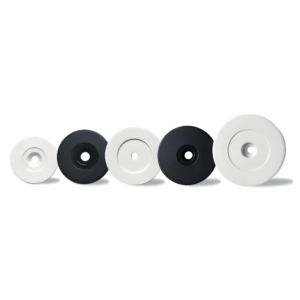NFC Guide: In-depth Read About Near-field Communication
While NFC is similar in many ways to RFID and its history is based on RFID, it is a separate concept. Where RFID has passive and active tags, active tags can be read from relatively long distances, and NFC, as its name suggests, works in the near-field region of electromagnetic fields.
RFID is still around and will be for the foreseeable future. NFC is a direct evolution of RFID, you might consider a parallel branch. At the most basic level, NFC is typically two inductively coupled devices whose communication is performed by modulating the power drawn by the passive devices. Passive RFID absorbs RF power, which is then used to transmit data back to the reader – Active RFID can use its own power source to transmit data back to the reader. As with NFC, there are always exceptions to the rule – Type 5 NFC tags work at longer distances (up to 1 meter).
In the most typical implementation of NFC, one device is the active device, acting as a master in communication and creating a modulated RF near field that will power passive slave devices. Active devices usually use the name of the reader, while passive devices are called tags. Common examples of tags include stickers and embedded systems; the most common NFC readers you might see in everyday life are smartphones or payment terminals.
NEAR FIELD COMMUNICATION
In typical RF communications, a transmit antenna transmits RF signals into free space, requiring an antenna of at least λ/4 (quarter wavelength) to be effective. When the distance between two RF devices exceeds 2λ (two wavelengths), for example, about 245mm (10 inches) for a 2.4GHz signal, it is usually possible to communicate with each other.
NFC instead communicates in the spatial near-field region below λ/2 (less than half the wavelength). The two near-field devices act as two coils of a coupled inductor or transformer wound around a common magnetic core.
RFID is still around and will be for the foreseeable future. NFC is a direct evolution of RFID, you might consider a parallel branch. At the most basic level, NFC is typically two inductively coupled devices whose communication is performed by modulating the power drawn by the passive devices. Passive RFID absorbs RF power, which is then used to transmit data back to the reader – Active RFID can use its own power source to transmit data back to the reader. As with NFC, there are always exceptions to the rule – Type 5 NFC tags work at longer distances (up to 1 meter).
In the most typical implementation of NFC, one device is the active device, acting as a master in communication and creating a modulated RF near field that will power passive slave devices. Active devices usually use the name of the reader, while passive devices are called tags. Common examples of tags include stickers and embedded systems; the most common NFC readers you might see in everyday life are smartphones or payment terminals.
NEAR FIELD COMMUNICATION
In typical RF communications, a transmit antenna transmits RF signals into free space, requiring an antenna of at least λ/4 (quarter wavelength) to be effective. When the distance between two RF devices exceeds 2λ (two wavelengths), for example, about 245mm (10 inches) for a 2.4GHz signal, it is usually possible to communicate with each other.
NFC instead communicates in the spatial near-field region below λ/2 (less than half the wavelength). The two near-field devices act as two coils of a coupled inductor or transformer wound around a common magnetic core.
NFC data rate
The maximum bandwidth supported by the NFC standard is 424Kbit/s, which is about eight times the speed of a traditional dial-up 56K connection. This limitation makes the standard comparable to Bluetooth in performance, at about half the data rate of version 4.0. Unfortunately, the standard has a lot of overhead, and most devices typically run at 50Kbit/s. Even with such limited data rates on the connection, and some ingenuity and creativity, the applications are endless. Since the memory on most tags is relatively limited, there is little need for higher data rates.
NFC memory
Most models of NFC tags contain 100 bytes to 1KB of memory, although available models have up to 64 KB of memory. These larger storage capacities are typically used for smart cards.
While this amount of storage may sound restrictive, it allows for a large number of 8-16-bit (1-2 bytes) sensor readings or data about what the Tag is attached to.

NFC tags, tags and basic ICs are widely used for asset tracking and thus need to be very affordable. If every item in a supermarket had an NFC tag on it, or every piece of clothing in a clothing store, even 50c per tag would quickly become unpopular. Fortunately, the simplicity of NFC makes it easy to produce tags and basic tags, which cost between 10c and 50c per tag, depending on volume.
When reading the NFC standards, you will find that they have been built to support a variety of existing standards and applications. Fortunately, for our sanity, few electronic engineers who have worked on mainstream NFC implementations need to understand the depth of NFC tag types. All modern smartphones must support each tag type in order to be NFC-compliant. The functions and characteristics of each NFC IC, whether active or passive, tag or reader, sticker or entire SoC, are clearly stated in the datasheet.
Tag Type 2 can meet the vast majority of NFC Forum Tag Type 2 NFC cards, self-adhesive labels and asset tags. Basic information storage and retrieval is possible via NFC communication or an I2C interface for connecting to a microcontroller.
Tag Type 4 primarily supports the ability to perform computations on a storage and retrieval basis as well as advanced security features. Finally, if you need to read for a long time and allow the user to interact with the label from a smartphone, you will need a marker type 5.
If you are building a reader for a custom application, the type of tags you use will most likely depend on the application and which tags are available for purchase, rather than choosing a specific tag type. If you’re building a custom tag, the choice is usually made for you as well, since the NFC IC used for the tag implementation will determine the tag type.
NFC Forum Tag Type 1
As the numbers show, NFC Type 1 tags are the simplest and very inexpensive of all NFC tag types. Typical Type 1 tags support read-only or write-once operations. However, R/W capable models are available, which typically have around a hundred bytes (2 Kbyte max) of memory and a relatively slow 106kbit/s bandwidth. Typical applications include stickers, marketing, product tracking, so these labels are of little significance to the average electronics engineer.
The standard used for NFC Type 1 tags is ISO-14443A.
NFC Forum Tag Type 2
Similar to Type 1 tags, NFC Type 2 tags only support ISO-14443A in read-only and read-write applications. Many Type 2 ICs provide energy harvesting functionality as well as I2C connections to external microcontrollers. However, Type 2 labels are commonly used as stickers, cards and tickets.
As mentioned above, Type 2 labels are the most common labels on the market and come in a wide range of shapes and sizes for labels attached to cable ties.
NFC Forum Tag Type 3
Type 3 tags based on the Sony FeliCa protocol are mainly used in Japan and Asia. In the relevant Japanese market, this tag type is frequently used for electronic money, identification, bus tickets and similar applications. The adoption of this standard in international electronic goods is limited, and its main uses include supporting legacy applications.
NFC Forum Tag Type 4
Type 4 tags compatible with the ISO-14443A and ISO-14443B protocols add support for the ISO-7815 standard for smart card identification. These tags can modify the data contained in their memory and are commonly used in security, identification and payment applications.
NFC Forum Tag Type 5
Type 5 tags are the latest specification to be published. The underlying physical layer is different from all other NFC tag types because it is based on RFID technology (ISO-15693) instead of ISO-14443A, allowing a read distance of up to 1.5m. However, like any other NFC tag type, customer NFC devices (such as smartphones) are limited to a maximum length of 10 cm, and interacting with further distances requires a specialized reader.



Types of NFC Interactions
NFC supports three main communication modes: read/write, peer-to-peer and card emulation.
NFC read/write mode
Read and write mode is the simplest and most common mode of operation in the NFC standard. An NFC tag implements a memory whose content typically consists of data in NDEF (NFC Data Exchange Format) format. A reader can read or write the contents of such memory.
The definition is very simple, but like most simple concepts in electronics, it is very versatile.
When NFC tags have full SoC (system-on-chip) functionality or are interfaced with an external microcontroller, they can often be accessed not only by the reader, but also by the tag itself. In this case, the tags act as dual-port memory, like a database accessed by two computers. Additionally, the tag itself can be powered by the NFC reader and/or an auxiliary MCU. Therefore, the Tag is always powered no matter where it is accessed, just like a database hosted somewhere on the Internet.
NFC peer-to-peer mode
In peer-to-peer mode, two active devices communicate with each other through one of two methods.
One device can be emulated as a tag and another device can be emulated as a reader. This situation is clearly a master-slave solution. It’s ideal for situations where there are “smart” and “clunky” parts of the system, such as a main microcontroller communicating with a smaller secondary MCU through a physical barrier. This mode also allows the system to maintain compatibility with smartphones, as the smartphone itself can act as the reader and the embedded device can act as the tag.
Implementing peer-to-peer networking through a protocol called LLCP (Logical Link Control Protocol) is a more abstract approach, but also more flexible to connect. The LLCP protocol is designed to allow arbitrarily flexible communication between two active devices similar to BSD sockets, and is familiar to many embedded and Unix programmers. Uniquely, the LLCP protocol allows the rapid porting of existing protocols such as Modbus, RS485, CAN, LIN or UART over NFC connections, enabling novel communication methods.
The disadvantage of exchanging data via LLCP protocol is the lack of support for smartphones, which can only be delegated to embedded-to-embedded communication or embedded-to-PC. If you’re building a custom NFC application, or can use NFC to meet project requirements without smartphone integration, the LLCP might be what you’re looking for if short-range wireless connectivity is required.






